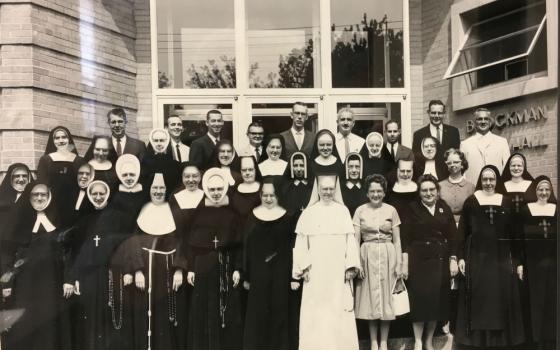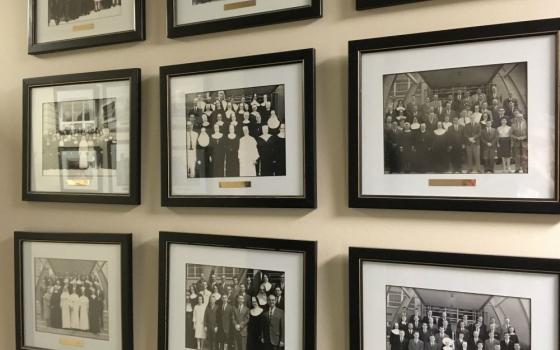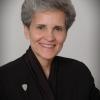Stately framed photographs line the corridor walls. There are 57 pictures with a new one added each year.
The earliest pictures start in 1960 and memorialize the health administration groups who started at Xavier University in Cincinnati in 1958 and graduated two years later.
Over the years, there have been numerous changes in the health administration program at Xavier, including a shift from being two years to three years' duration, beginning in the 1990s when the complexities of what needed to be taught in this graduate program overflowed the one year of didactic coursework followed by one year of administrative residency.
Perhaps the most visible change is that of class composition. In the early years, each class was mainly sisters, while occasional lay persons rounded out the group. In the 1970s and '80s, the number of lay persons increased significantly, and then the sisters became the occasional persons in the group. Over the recent past years, there are no sisters in these full classes of lay men and women. There's a marked increase in diversity, and today women outnumber men.
The faces of the sisters in those early days appear pleasant with dutiful smiles. What were they thinking? Did they really want to run hospitals for their orders? Were they already nurses for whom the switch to healthcare administration would be fairly smooth? Or were they pulled out of successful school principalships to answer the new call set before them by their superiors based on the logic, "You have leadership skills to run a school, so you can surely run a hospital. We need you to run our hospital."
I, too, am one of those faces on the wall. My order gave me a choice: "You can either be a school principal or a hospital administrator." My response was sassy for a young sister in those days: "What kind of a choice is that? I don't know anything about running a hospital."
The mother general at the time was a kind yet contemporary thinker who just laughed. She could have gotten angry or been unhappy with me, but she didn't. She laughed and said immediately, "Yes, we know this. How about if we let you spend the summer at a hospital with one of our sister-administrators so you can find out what that ministry is all about?"
And find out I did. I really enjoyed the summer exploring hospital administration. I was very thankful to bring all my teaching skills and experience because everything fit. Yes, I was ready to make my choice of hospital administration over being a school principal.
I happened to be the only sister in my graduating class of 1980. The look on my face in that class photo is resolute, ready and smiley. I knew why I was studying hospital administration and I was glad to be invited to do that. All of us in the class were planning for jobs running hospitals.
Ah yes, running a hospital. Before 1875, hospitals were places people went to die. They were places of last resort since cures didn't happen there, and options for saving lives didn't exist.
But a number of advancements in healthcare around the turn of the century changed all that. X-rays were discovered. Anesthesia began and enjoyed broad use in hospitals. The EKG was invented. Lab tests became a diagnostic arsenal. Penicillin and the powerful sulfa drugs (antibiotics) were discovered. Diagnosis, surgery and controlling infections breathed life into hospitals themselves, making them places of life, not death.
In the 50 years after 1875, the number of hospitals in the USA grew from 170 to more than 7,000. During that timeframe, it became clear that professionally trained administrators were needed to run hospitals.
Hospitals were 'businesses" that were unlike any other entity in a community. Hospitals weren't banks, weren't manufacturing plants, weren't retail stores, weren't schools and weren't restaurants — the entities that folks knew how to manage.
Hospitals were businesses, yes, but they also had the mission and focus to care for people whose lives depended on before-unheard of things like quality management, infection control, aseptic technique, sterilization of instruments and drug formularies. Peoples' lives have always been about life and death, so what did it take to ensure that hospitals would be more about life?
A hospital is a city unto itself. It's a hotel with overnight rooms. It's a restaurant with food service. It's a church, a police force, a power plant with emergency generators, a building having safety requirements, a financial operation with bill collecting, and a diagnostic and treatment facility. It's typically governed by a board of community and medical leaders. It's a place providing highly trained clinical, professional and support employees to care for patients, side-by-side with physicians and surgeons who — in those early days — were credentialed as external persons, not as employees.
Who ran these hospitals? Sometimes a physician or sometimes a nurse. But it quickly became clear that a hospital was unlike any other community organization having a business overlay. So enter the specialized study of hospital administration. The first program in the country was founded in 1938 at the University of Chicago. Xavier University in Cincinnati, where these pictures are, was the country's 15th such program founded in 1958.
Today — 2018 — 60 years later, I look at the framed class pictures along the corridor wall. Many persons pictured are smiling, eager and ready to make their mark in healthcare administration. Others look somewhat unsure of what the future may hold for them.
But then I come back to the sisters in those early pictures. I see obedience in their faces, yes, but I also see a determined sense of mission and purpose. Sisters may feel nervous about a ministry, but they know that God will give the grace to understand, to persevere, and to do a great job. Just look at the wonderful legacy of Catholic healthcare created by religious sisters.
The pictured sisters in the corridor stepped out of those 1960s group photos to set foot in the new ministry of professional health services administration. What a wonderful and incredible service they've given for the untold patients who've trusted hospitals sponsored by the sisters' congregations for decades.
Indeed, these sisters forged ahead to run hospitals. I was one of them. I think history will judge us all as doing that very well.
[Nancy Linenkugel is a Sylvania Franciscan sister and chair of the department of Health Services Administration at Xavier University, Cincinnati.]


